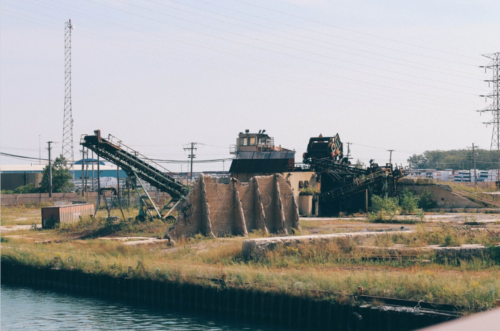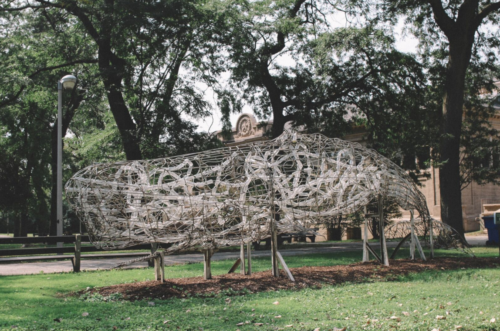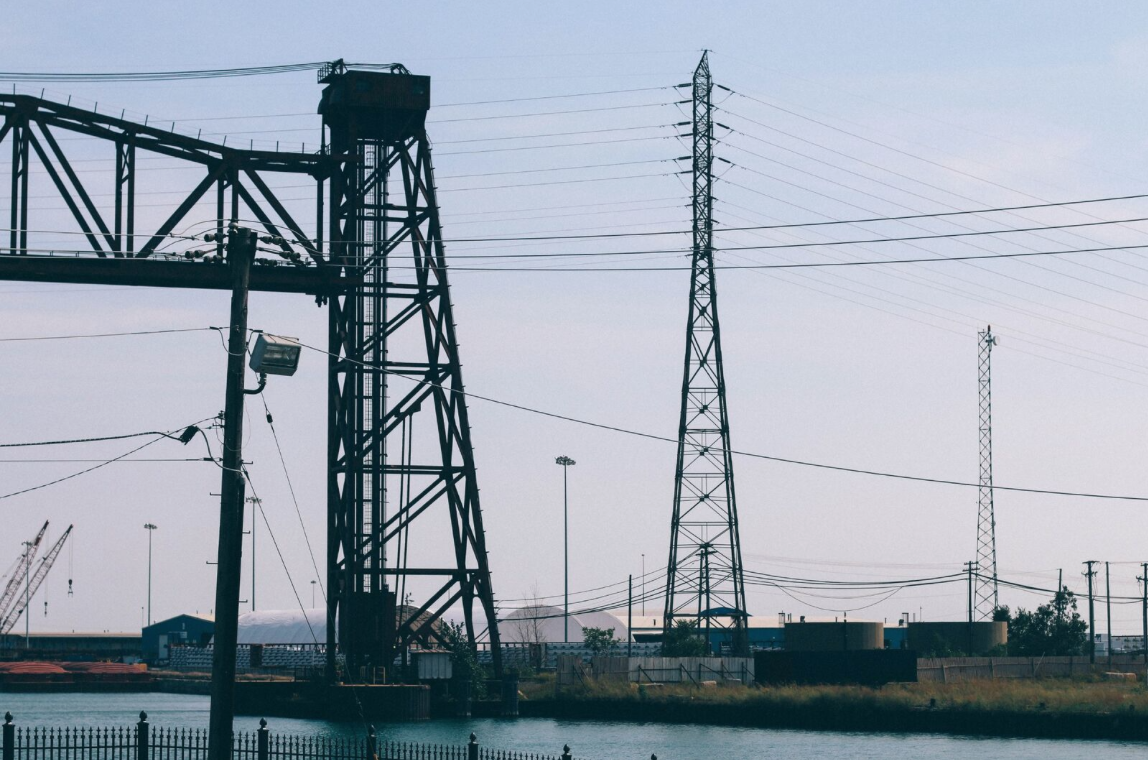- • Best Ecological Redemption & Place to Take Your Bike
- • Best Burial Site of a Waterloo Veteran
- • Best Historical Society
- • Best Way to Spend a Long Weekend
How has the neighborhood changed since the steel mills closed?
Well, I suppose the first thing you need to do is look at what the neighborhood was like when the steel mills were open. There was always a job. I got a friend who wrote a book about growing up in South Chicago. He worked—he told me he worked in five different mills. It was the type of thing where you could work in a mill, get into an argument with your foreman, tell him to go screw himself, walk down the street, and go get a job at another mill almost automatically. They were that common.
When I graduated high school, most of my friends went to work in the mill. I went to college. Well, I was putting myself through college, and they were driving nice cars because they were making good money in the mill. So, you know, it was a thriving place. Commercial Avenue, the shopping district that they had, they talk about it going twenty-four hours a day because the mills were on shift work. They worked 24/7 because you can’t shut down the blast furnaces and the other furnaces without causing damage to them. So they ran in, you know, three shifts. And you could tell what was going on with traffic—you could tell when the shifts were changing from traffic patterns. The most common shifts were three-to-eleven, eleven-to-seven, and seven-to-three. Or four-to-twelve, twelve-to-eight, and eight-to-four. The mills tried to stagger them a little bit, so everyone wasn’t coming in at exactly the same time.
But when the mills started to close, then you ran into the difficulty of—where are people working? A question that I get a lot, and it’s very difficult to answer—and, you know, before it was an easy question—now people come in and say, where do people from that area work? What do they do? Not an easy question to answer. In recent years, they have expanded commuter railroad service. They built a couple of new parking lots for commuter railroad. So in some respects it sort of reflects a commuter neighborhood, a bedroom-suburb type thing. But you will not find the consistency of people working in the mill or working in a particular job now that you used to. It’s still, for the most part, seen as a relatively favorable place to live, so people who have to live in the city, because they have a city job, will often come to this area.
You know, so, like I say…neighborhood’s changed. Still not a bad place to live. But it doesn’t have the economic—as one guy said—the economic engine that the mills provided. You have to realize that the mills not only provided these steel jobs, you know for people working there, but also all those other jobs, which were related to steel—smaller factories, smaller mills, even grocery stores and taverns. You know, you could walk outside of a mill and see six taverns. Because mill workers, if they had a break where they could get away, that’s where they would go and get a drink. And if they didn’t drink there during work, they certainly did after.
Rod Sellers, born in 1946, grew up in South Chicago before moving to Burnside, and later the East Side. He taught history and social studies in three area high schools until his retirement in 2002. He now lives in Frankfort, a southwestern suburb, but maintains ties to the community as the director of the Southeast Chicago Historical Society.
Best Ecological Redemption Story & Place to Take Your Bike
Big Marsh Bike Park
Sue Garza used to go watch what she and her friends called the “light show:” the spectacle of molten slag pouring from the steel mills near Lake Calumet. The show, along with most of the industry around Lake Calumet, is long gone. But Garza, now alderwoman of the 10th Ward, still goes down to the marshes near the lake: she takes visitors to her ward to a swath of land adjacent to the lake to show off the wild, verdant area that will soon become Big Marsh Bike Park. The park, opening this fall, will be one of the biggest in Chicago; at 278 acres, it’s nearly the size of Grant Park. Taking into account the nearby former dumping sites that will be connected to Big Marsh by trails, the extended network of parks will cover over 1,000 acres. It will also be one of the first pieces of lakefront property (Calumet Lake-front, that is) open to the public; the rest is owned by the Port Authority, Harborside International Golf Center, and private industry. The goals of the park are threefold: to provide a world-class destination for bike recreation (replete with competition-ready features and trails), attract money and jobs to the community, and call attention to the rehabilitation of the industrially degraded habitat. Whatever the end product accomplishes, it will be worth a visit when it opens in late fall. Bring your bike. (Lewis Page)
Big Marsh Bike Park, 1958 E. 116th St. (312) 742-7529. bigmarsh.org
Best Burial Site of a Waterloo Veteran
Sims Metal Management

The body of Andreas von Zirngibl, with the exception of the arm he lost in the Battle of Waterloo, rests in the middle of an inactive recycling plant in Southeast Chicago. Formerly Sims Metal Management (before they shut down operations on the site in November), the lot looks like what might have happened if the Seventh Coalition had decided to turn their sights from the French and instead take on and defeat an army of used cars, rocks, and industrial equipment. Dismembered car parts, chunks of concrete, and looming machinery lie scattered across the unused lot in its picturesque location on the banks of the Calumet River, where von Zirngibl established a homestead in 1854. Upon his death in 1855, his family, according to his request, buried him there, surrounded the site with a white picket fence, and visited regularly. Now, one of the city’s smallest official gravesites, von Zirngibl’s tombstone stands alone, surrounded by concrete blocks and a chain-link fence. These lines of defense were placed there by the Southeast Chicago Historical Society in 1987, along with a new gravemarker which mistakenly lists the Battle of Waterloo as having taken place in 1816 (it took place in 1815). Von Zirngibl has been luckier in death than at Waterloo; through a string of legal battles headed by his ancestors, his gravesite has persisted, albeit now surrounded by private property. If you want to visit the tomb and pay your respects legally (without hopping any fences), contact Sims Metal Management and ask for a security guard to guide you on a tour. (Lewis Page)
Sims Metal Management, 9331 S. Ewing Ave.
Best Historical Society
Southeast Chicago Historical Museum

Most people skim across the surface of history, barely putting in the effort to recall what they ate for lunch, let alone what their neighborhood looked like fifty years ago. Thankfully, some people, like the good folks at the Southeast Chicago Historical Society (or Museum, depending on who and when you ask), give the past the attention it deserves. The society and museum are housed in a room in a beautiful old building in Calumet Park, which over the years has accumulated an admirable collection of memorabilia, artifacts, images, and periodicals associated with the neighborhood. Years of publications like the Daily Calumet, a miniature model of Commercial Avenue, and tens of thousands of family photographs, among other gems, have been collected and put on display. The eclectic collection is more than an object of curiosity: as Rod Sellers, director of the museum, notes, the area serves as a microcosm of American history, and as a rich case study of migration, history, community, industry, and environment in Chicago and America. From academics doing research for books to high school students in a class on museology, the space has served and benefited from the interest of many. The museum is only open one day a week, for three hours, but it’s worth planning your week around. What it lacks in organization or professional curation, it more than makes up for in a wealth of resources and warmth of community. Ask to be shown around, rummage around, and revel in the weight of history. (Lewis Page)
Southeast Chicago Historical Museum, 9801 S. Avenue G. Thursdays, 1pm–4pm. (312) 747-6039.
Best Way to Spend a Long Weekend
10th Ward Labor Day Parade and Festival
In a heartwarming move worthy of a made-for-TV holiday special, Alderwoman of the 10th Ward, Sue Garza and company, put the “labor” back in Labor Day. The first celebration of its kind since the dissolution of the East Side Labor Day Parade in the nineties, the 10th Ward Labor Day Parade and Festival filled the streets of the Southeast Side for three long, late-summer days this year. The festivities harkened back to the ward’s industrial past, but also showed that labor’s legacy is alive and well. Community organizations and locals of all trades and industries marched, alongside “Scabby,” the giant inflatable rat that usually haunts under-conflict worksites as a symbol of the much-maligned strikebreaker. Although the festivities are over for this year, the date is one to mark on your not-yet-bought 2017 calendar. In the meantime, as the long work year stretches out in front of you and the seasons change, keep Sue Garza’s sentiment in mind: “You deserve to celebrate your work.” (Lewis Page)
10th Ward Labor Day Parade, E. 104th St. and S. Ewing Ave. to E. 112th St. and Eggers Grove. Saturday of Labor Day weekend.
10th Ward Labor Day Festival, Steelworkers Park, E. 87th St. at Lake Michigan. Friday, Saturday, and Sunday of Labor Day weekend.


Great stuff